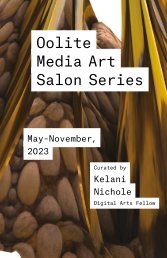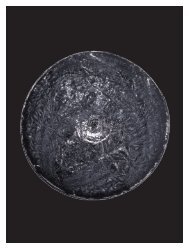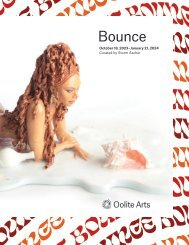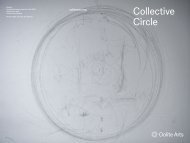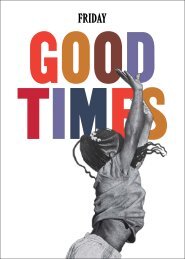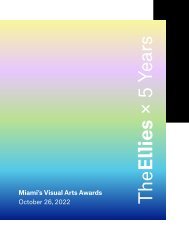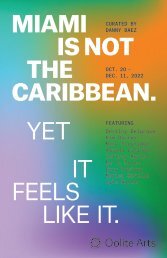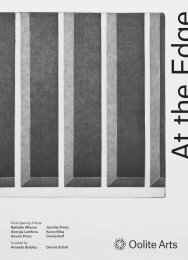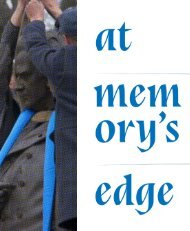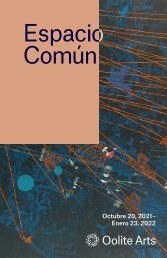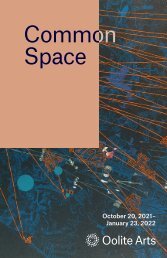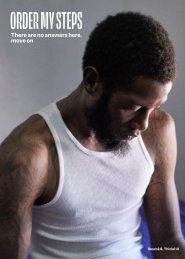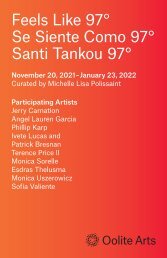You also want an ePaper? Increase the reach of your titles
YUMPU automatically turns print PDFs into web optimized ePapers that Google loves.
Curated by Laura Marsh
July 22 – September 27, 2020
Floorplan
2
First Floor
Yanira Collado, Untitled, 2018. Textile,
found debris, custom-made frame,
40x51 inches. Courtesy the artist.
Mark Fleuridor, Le San de Jezi, 2018.
Quilting, screen printing, fabric
dying, 76×30 inches. Courtesy the
artist
Paloma Izquierdo, Bate, 2020.
Baseball bat, TV mount, approx.
3×2×1 feet. Courtesy the artist
T. Elliot Mansa, New Millennium
Spirit Jar I, 2019. Glass, clay, plastic
acrylic paint 11×7×7 inches.
New Millennium Spirit Jar III, 2019.
Glass, clay, plastic, seashell, bells,
acrylic paint, 6×7×7 inches.
New Millennium Spirit Jar II, 2019.
Glass, clay, plastic, seashells,
acrylic paint 11×12×6 inches.
All works courtesy the artist
Marielle Plaisir, Sister Bakhita | In
Serie Blue Blood, Black Blood, 2019.
Printing in resin, feathers on fabrics
stuffed, 12×9 inches. Courtesy the
artist
Roscoè B. Thické III, Freedom, 2020.
Photography, 24×36 inches.
Courtesy the artist
Roscoè B. Thické III, Mental Prison,
2020. Photography, 20×20 inches.
Courtesy the artist
Second Floor
Gallery
1 Phillip Karp, Untitled, 2019. Archival
pigment print on vinyl, dimensions
variable. Courtesy the artist
2 Felice Grodin and AdrienneRose
Gionta, fired out in the stream
expect to measure zero, 2020.
Site-specific enviroscape,
dimensions variable. Courtesy the
artists
3 Mark Fleuridor, Saturday Massage,
Channel 45 time and Lwil Maskriti,
2019. Quilting, 44×30 inches.
Courtesy the artist
4 Yanira Collado, Untitled, 2015.
Textile, cardboard, paper, paint, ink,
oil paint, 56×58 inches. Courtesy
the artist
8 Department of Reflection,
Fieldwork: Dispatches #38 (with
Special Guest Jenna Carr Balfe),
2020. Live-recorded online
presentation. Made possible with
commissioning support by partners
including Commissioner and the
City of Miami Beach.
9 Nick Mahshie, Fragment from
[6:20am-8:41pm / Miami], 2019.
Cotton, fabric, mesh, dye, ink,
dimensions variable. Courtesy the
artist
10 Jen Clay, I Grew When You Weren’t
Looking (Mound), On-going series,
2020. Tufted rug textile, carved
foam, felt, dimensions variable.
Courtesy the artist.
11
13
12
10
9
1
3
6
8
2
4
7
5
5 Diego Gutierrez, The Earth Will
End, 2019–20. Acrylic, crayon, oil,
ceramic, fabric on wood, 33×44
inches. Courtesy the artist
11 Gonzalo Fuenmayor, The Outlines
of Joy, 2019. Charcoal on paper,
60×75.5 inches. Courtesy the artist
and Dot Fiftyone Gallery
6 T. Elliot Mansa, A dream deferred,
2017. Baby walker, toy, plastic
flowers, spray paint, black gesso,
32×31×32 inches.
The Beautiful Ones, 2018. Baby
seat, bottles, beads, wire, plastic
flower spray paint and black
gesso, 30×26×36 inches. All works
courtesy the artist
12 Roscoè B. Thické III, The Box,
2020. Photography, 16×20 inches.
Courtesy the artist
13 Sasha Wortzel, We Have Always
Been On Fire, 2019. Video, color,
sound, 6 minutes. Courtesy the
artist
7 Nabila Zoraya Santa-Cristo,
Let Sleeping Dogs Lie, 2020.
Cardboard, foam, plastic, clay,
fabric, wax, and oil paint on paper,
3×4 feet. Courtesy the artist
Nabila Zoraya Santa-Cristo
3
Idioms and
Taxonomies
Laura Marsh
Director of Programming
Idioms and Taxonomies is an exhibition
by Oolite artists-in-residence whose
practices investigate the dual roles
of personal and cultural histories. Let
Sleeping Dogs Lie by Nabila Zoraya
Santa-Cristo, evokes an idiomatic
expression that tells us to leave things
as they are, undisturbed. But are
we comforable, either personally or
culturally, to just accept that events
will play out beyond our control? That
quandary is as relatable now, in our
current pandemic, as in Chaucer’s first
Sasha Wortzel
popular use of the expression in 1380.
By comparison, the word “FRIENDLY”
wraps around a gallery wall in Phillip
Karp’s photograph Untitled, enveloping
viewers with its intimate proximity.
Juxtaposing words and objects to imbue
new meanings resonates throughout the
work of the exhibition’s fifteen artists
and additional collaborators.
“We’ve always been left out . . . We
have always been an island . . . an i, i,
island” reverberates in Sasha Wortzel’s
film and installation We Have Always
Been on Fire. The Fire Island dunes
and dance clubs paired with a song
by Morgan Bassichis are intercut with
Nelson Sullivan’s documentary footage
from New York’s downtown art and
club scene in the 1980s, reflecting
upon the lineage of queer subculture
with feelings of loss yet hopefulness
for the future. Misael Soto works with
the concept of bureaucracy in his
ongoing social project The Department
of Reflection, officially adopted by
5
Misael Soto
Phillip Karp
6
Mark Fleuridor
Yanira Collado
Nick Mashie
the City of Miami Beach. Soto invites
local artists to dialogue about how art
can intersect with city government.
Here and elsewhere, contemporary
art practices embrace cross-cultural
connections and seize on opportunities
found in the seemingly mundane
material of everyday life.
Mark Fleuridor’s Saturday Massage,
Channel 45 time and Lwil Maskriti
calls up the uneasy sensation of
parental surveillance. In this quilted
sculpture, a TV preacher gestures
towards the viewer and a motherly
figure, awaiting a massage, gazes
back at us, amid hand-dyed textiles
composed into intimate family
portraits. Also in conversation with
fiber, Yanira Collado layers and paints
recycled fabric, referencing her
Dominican background and familial
history with industrial fabrics. Jen
Clay’s I Grew When you Weren’t Looking
is a foliage-like and fleshy sittable
7
Gonzalo Fuenmayor
Diego Gutierrez
Felice Grodin and AdrienneRose Gionta
sculpture. The layers of tufted yarn
build a sensual tactile surface, making
us think of moss and other bryophytes
on a forest’s floor. By combining neutral
beiges with pinks, one also thinks of
human skin, which makes the form
even more tempting to touch.
In Nick Mahshie’s vibrant work,
layers of mesh material overlap and
emerge into intersecting patterns
that echo the Lincoln Road setting.
His process explores an architectural
memoryscape, taking inspiration
from Miami neighborhoods and
the urban sprawl transiting their
boundaries. Felice Grodin shares a
similar sensibility and collaborates
with AdrienneRose Gionta to produce
a video work exploring human’s
relationship to both the natural and
digital worlds. In fired out in the stream
expect to measure zero, Grodin and
Gionta digitally layer atmospheric
effects with symbols, responding to
issues of climate change.
Alluding to Christian basilicas
and nineteenth-century ballrooms,
Gonzalo Fuenmayor’s elaborate drawing
also responds to Miami’s European
revivalist architecture, with oculi that are
actually South Florida swimming pool
designs. In Diego Gutierrez’s The Earth
Will End, fractured trees and cityscapes
emerge from a pastel patchwork of
mini-paintings compressed within
the lid of a shipping crate, revealing
concerns for the precarious state of the
natural environment and the manmade
economy. As a painter, Gutierrez often
prefers found objects to canvas on
which to construct his meaningful
associations, a tactic seen in the work
of fellow residents.
8
Yanira Collado, Mark Fleuridor, Paloma
Izquierdo, T. Eliott Mansa, Marielle
Plaisir, and Roscoè B. Thické III,
reference both personal and cultural
histories in works featured in Oolite’s
first-floor vitrine, subtitled Memorials
and Monuments. In Thickè’s Freedom,
the photographic subject bears a
deadpan expression that is both
disorienting and powerful. The lines on
his palms form a tangent with the bars
of the window in a diagonal composition
that adds dramatic effect to the plight
of an individual under house arrest. For
Mansa, roadside memorials and hope
jars are folk memorabilia. Faux flowers,
bottles, and other media become
saturated with black and blue paint,
Roscoè B. Thické III
9
10
Marielle Plaisir
evoking the American South and a
longing for community connection.
Plaisir’s textile work pays homage to
Saint Josephine Margaret Bakhita,
a Sudanese-Italian religious sister
who was declared a saint by the
Catholic church after having been a
slave. This multilayered history is a
current that runs through Memorials
and Monuments, revealing untold
narratives. In Izquierdo’s work, the
artist installs a bat to memorialize
an action rich in cultural history. In her
Untitled sculpture Collado’s patchwork
leans against the wall, mimicking bolts
of fabric aligning a cluttered fabric
shop. This association provides viewers
with that feeling of discovering a
color or texture and finding unlimited
material potential in a discarded scrap.
Idioms and Taxonomies reflects
upon human conditions, navigating
black, feminist, and queer spaces
through multilayered environments.
11
Paloma Izquierdo
T. Elliott Mansa
Conversations about how to depict
subjects, protect cultural heritage,
preserve architectural memory, and
reflect upon diaspora all shape the
practices of these artists. The works
displayed conflate historical and
contemporary points of reference,
and their nuanced messages implore
viewers to examine their own
relationship to space, community,
and isolation.
924 Lincoln Road
Miami Beach, FL 33139
Tag us: @OoliteArts • #OoliteArts
OoliteArts.org
Board of Directors
Kim Kovel
Eric Rodriguez
Reagan Pace
Marie Elena Angulo
Donnamarie Baptiste
Alessandro Ferretti
Lilia Garcia
Jane Goodman
Adler Guerrier
Thomas F. Knapp
Jeff Krinsky
Lin Lougheed
Maricarmen Martinez
David Siegel
Deborah Slott
Merle Weiss
Staff
Dennis Scholl
President and CEO
Aaron Feinberg
Chief Financial Officer
Esther Park
Vice President of Programming
Laura Marsh
Director of Programming
Cherese Crockett
Exhibitions & Artist Relations
Manager
Jason Fitzroy Jeffers
Cinematic Arts Senior Manager
Dan Weitendorf
Facilities Manager
Anais Alvarez
Communications & Development
Senior Manager
Jessica Rivas
Membership Development Manager
Michelle Lisa Polissaint
Education and Community Engagement
Manager
Juan Matos
Digital Content Producer
and Coordinator
Amanda Bradley
Programs Manager
Melissa Gabriel
Art Classes Coordinator
Catalina Aguayo
Executive Assistant
Rebecca Lee
Communications Coordinator
Exhibitions and programs at Oolite Arts are made possible with support from the Miami-Dade County Department of
Cultural Affairs, the Cultural Affairs Council, the Miami-Dade Mayor and Board of County Commissioners; the City
of Miami Beach Cultural Arts Council; the Miami Beach Mayor and City Commissioners; the State of Florida, Florida
Department of State, Division of Cultural Affairs, the Florida Arts Council; the National Endowment for the Arts; the
Lynn & Louis Wolfson II Family Foundation, The Jorge M. Pérez Family Foundation at The Miami Foundation; the Al
& Jane Nahmad Family Foundation and the John S. and James L. Knight Foundation. Additional support provided by
Walgreens Company.




